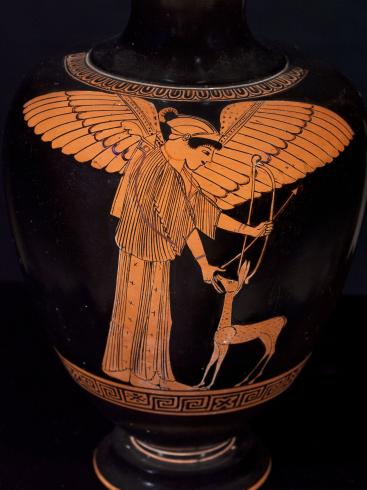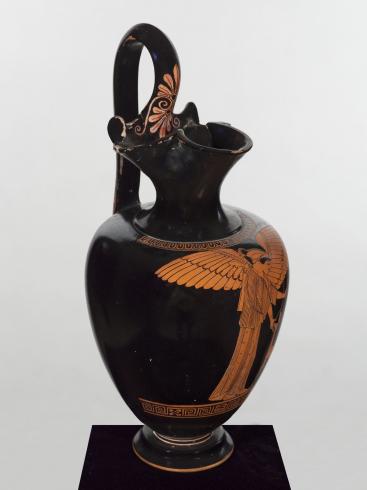The Dutuit painter retains links with black figure decoration. His gracious miniaturist style continues in red figures, perpetuating the tradition of the “Little Masters” who decorated cups with black figures. It is to this vase acquired by the collector Auguste Dutuit that the painter, whose identity is unknown, owes his nickname.
This scene expresses all the delicacy characteristic of his style, taken almost to the point of preciousness. The winged goddess Artemis is standing in right profile. She holds a bow and arrow in her left hand and with the tips of the fingers of her right hand she lightly strokes a young fawn which is facing her.
Her bare feet, indicating close contact with nature, contrast with her elegant finery – a delicately-embroidered tunic, a pendant necklace, bracelets and hair styled in a high bun with ringlets escaping from a broad draped headband or cecryphale. Over her left shoulder is a lidded quiver containing her arrows, held in place by a shoulder strap.
The smallness of the fawn and its huge ears betray its extreme youth. With trusting innocence it is lifting its muzzle to respond to the invitation of the goddess whose fingers encircle it without touching it. Fearless, it is completely in Artemis’ power, as is highlighted by the elements of the composition : the fawn’s hooves are almost touching the goddess, its long ears look as if they are trapped between the bow and its string and they exchange glances. The painter subtlety conveys the hold the goddess has over all forms of animal life. Her deadly bow is temporarily stilled and her arrow points skyward. Artemis will surround the fawn with her warmth and protection until it reaches maturity.
Yet Artemis has appeared as a winged deity since the archaic period in the guise of Mistress of the Animals (Potnia Therôn). She is always depicted full-face flanked to either side symmetrically by animals, often lions rampant, symbols of the absolute authority of the goddess and her power of life and death over all animals, both those which threaten human life and those which nourish it.
The Dutuit Painter’s vase has no other meaning. Beneath the apparent goodwill of the young Artemis, threatening implications can be clearly felt.
P. P.-H.

City of Paris municipal collection's website
The collections portal can be used to search the collections of Paris’s 14 municipal museums (approximately 336,000 works, including 43,000 belonging to the Petit Palais).
It is also possible to download around 12,000 images of the museum’s works free of charge.
Access the Museums of the City of Paris collections portal
Extern databases
Discover a selection of databases online presenting works from the Petit Palais or documents concerning the history of the museum.


